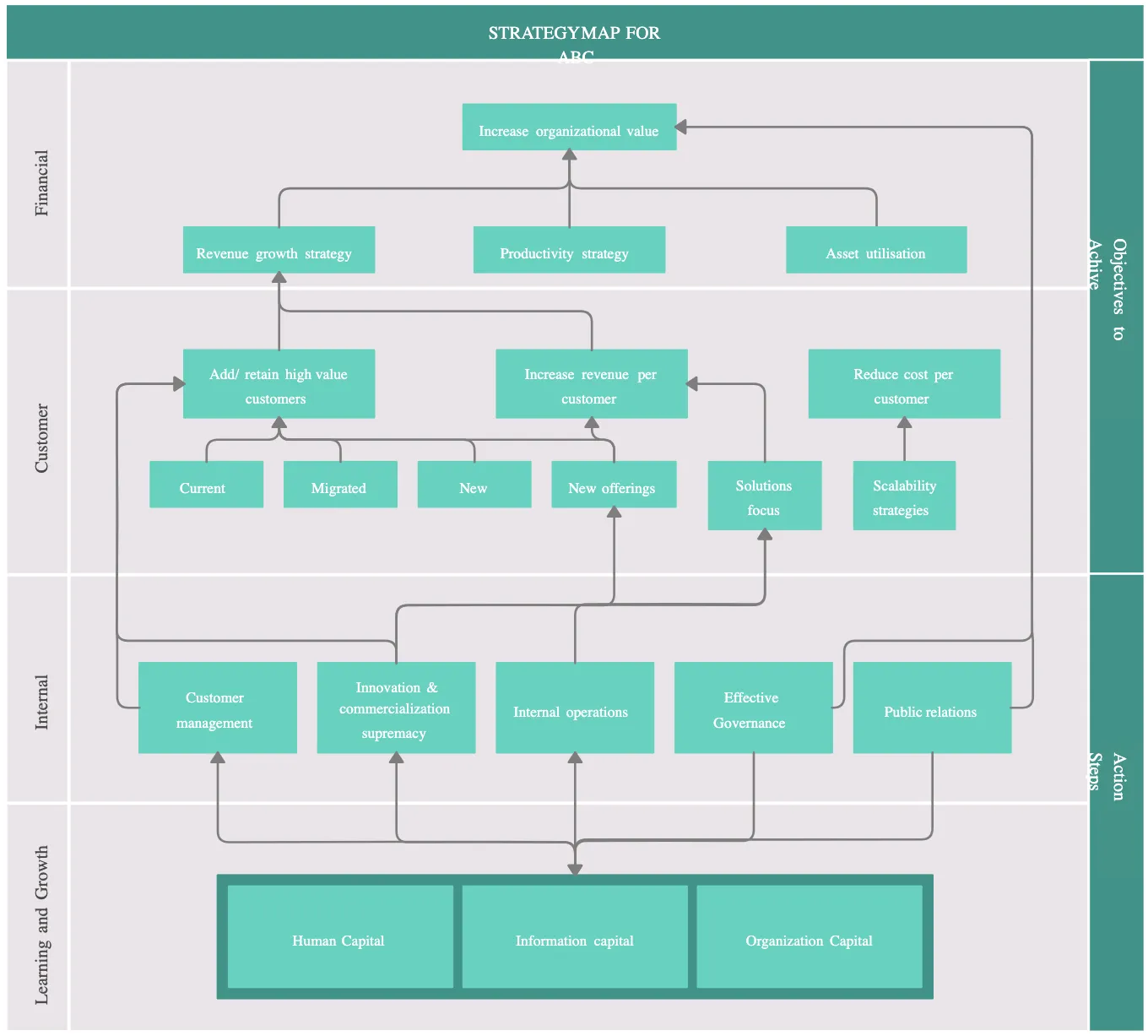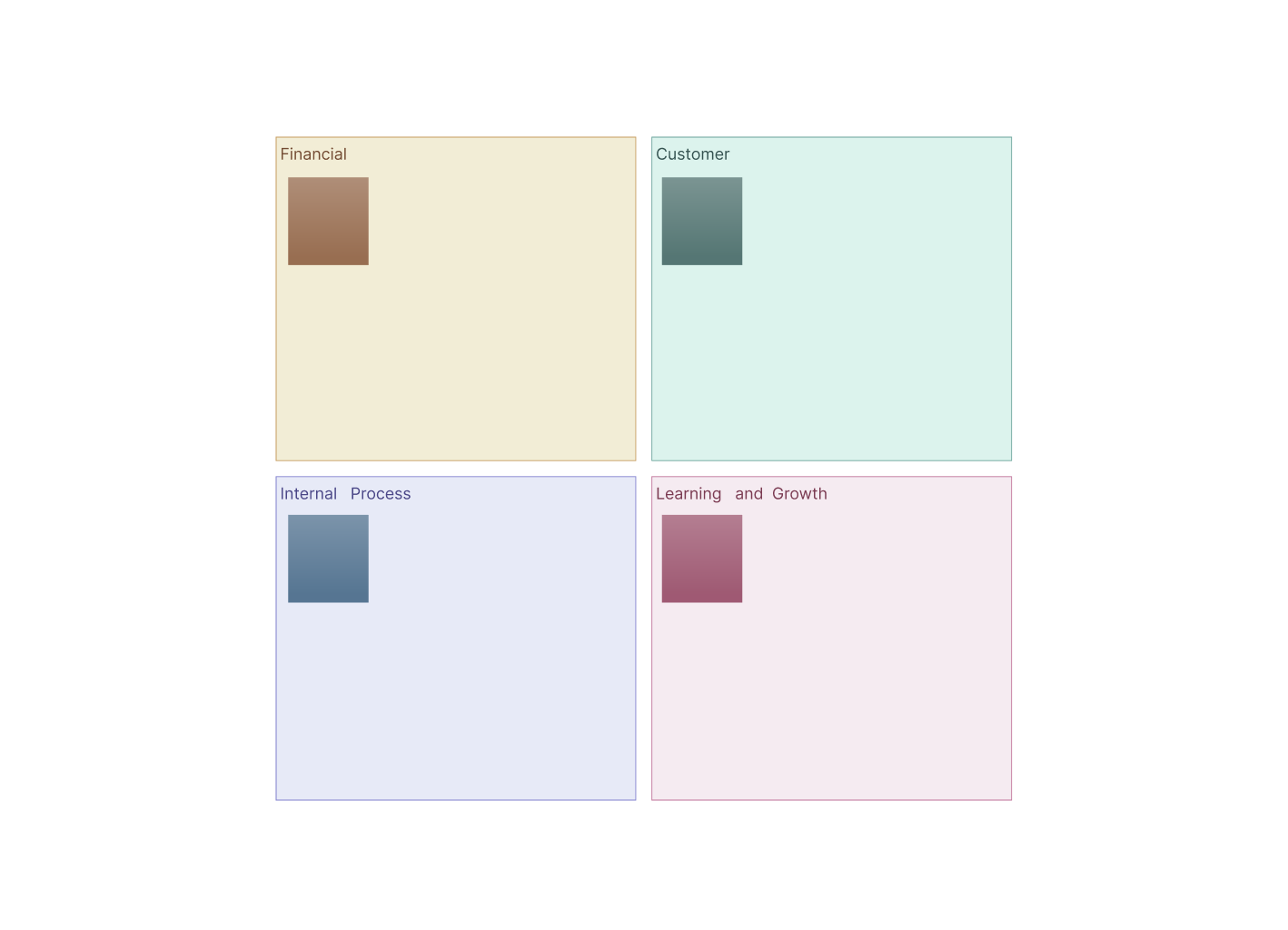Many organizations craft brilliant strategies only to see them stall in execution, lost amid daily tasks and misaligned priorities. That’s where strategy maps and balanced scorecards come in: the map shows how your objectives connect, while the scorecard turns them into measurable actions. Together, they bridge the gap between planning and results, keeping your team aligned, focused, and moving toward the same goals.
Why Use a Strategy Map and Balanced Scorecard Together
The strategy map shows your goals visually and how they connect, while the balanced scorecard turns those goals into measurable actions. Together, they make it easier to understand the strategy, track progress, and keep everyone aligned.
See the big picture – The strategy map shows all your goals and how they connect, so it’s easy to understand the overall plan.
Turn goals into action – The balanced scorecard breaks each goal into measurable steps with clear targets.
Keep everyone aligned – Leaders and team members all know what to focus on and how their work matters.
Track progress easily – Using metrics from the scorecard, you can see what’s working and what needs improvement.
Make smarter decisions – Real data helps you adjust plans and achieve better results.
Understanding the Strategy Map
A strategy map is like a visual blueprint for your organization’s goals. It shows what you want to achieve and how different goals connect to drive success. By looking at a strategy map, everyone can see the big picture, understand their role, and how their work contributes to the organization’s overall strategy.
Key points to understand about strategy maps:
What it is and its purpose – A strategy map is a diagram that organizes objectives visually, helping teams see how goals work together to achieve the organization’s vision.
Benefits – Makes strategy clear and easy to communicate, aligns teams, and helps link daily actions to overall goals.
The four perspectives – Most strategy maps use four areas to organize objectives:
Financial – Goals related to revenue, profit, or cost efficiency.
Customer – Goals focused on customer satisfaction, loyalty, or market share.
Internal Process – Goals for improving processes, productivity, or quality.
Learning & Growth – Goals for employee skills, culture, and knowledge management.
Causal relationships – Objectives are connected to show how achieving one goal helps achieve another, creating a logical cause-and-effect flow.
Strategic themes and storytelling – Objectives can be grouped into themes (like growth or operational excellence) to tell a clear story of how your strategy drives results.

Understanding the Balanced Scorecard
A balanced scorecard is a tool that turns your strategy into measurable actions. While a strategy map shows what you want to achieve and how goals connect, the balanced scorecard tracks progress, sets targets, and ensures your team is actually moving toward those goals. It helps you focus on more than just financial results by balancing multiple perspectives.
Key points to understand about the balanced scorecard:
What it is – A framework that links objectives from your strategy map to specific measures (KPIs), targets, and initiatives.
Purpose – Helps organizations monitor performance, improve decision-making, and ensure alignment between goals and actions.
The four perspectives – Same as the strategy map, each perspective has measurable goals:
Financial – Track revenue, profitability, or cost savings.
Customer – Measure satisfaction, retention, and market share.
Internal Process – Track efficiency, quality, and process improvements.
Learning & Growth – Measure employee skills, training, and innovation.
KPIs and targets – Each objective is linked to key performance indicators (how success is measured) and specific targets.
Strategic initiatives – Actions or projects your team undertakes to achieve the objectives.
Why it matters – Provides a clear picture of performance, helping leaders make informed decisions and adjust strategy when needed.

How the Balanced Scorecard and Strategy Map Work Together
Step 1: Define your big goal
Start with your overarching objective, like “Increase annual revenue by 20%” or “Become the most customer-friendly company in our market.”
Example: A small café wants to grow loyal customers while keeping costs manageable. Their big goal: “Grow profits by improving customer satisfaction and efficiency.”
Step 2: Map out your objectives (strategy map)
Break the big goal into smaller, connected objectives across the four perspectives and create a strategy map: Financial, Customer, Internal Process, Learning & Growth.
Example (for the café):
Financial: Increase monthly revenue by 15%
Customer: Improve customer satisfaction scores
Internal Process: Speed up order delivery
Learning & Growth: Train staff on customer service skills
Draw arrows or links to show how one objective drives another — this is the cause-and-effect logic.
Step 3: Assign measurable actions (balanced scorecard)
Once your strategy map is ready, the next step is to create a balanced scorecard by turning each objective into measurable actions. This means defining KPIs (Key Performance Indicators) that will help you track progress and success.
Example (for the café):
Financial KPI: Monthly sales revenue
Customer KPI: Customer satisfaction survey score
Internal Process KPI: Average order fulfillment time
Learning & Growth KPI: Number of staff training hours completed
By creating a balanced scorecard, you can see which areas are performing well and which need improvement, ensuring your strategy is not just a plan, but a measurable, actionable roadmap.
Step 4: Set targets and initiatives
For each KPI, define a specific target and the actions you’ll take to reach it.
Example:
Target: Raise customer satisfaction from 80% to 90%
Initiative: Implement a new barista training program and a loyalty rewards system
Step 5: Monitor progress
Regularly check the balanced scorecard to see how your KPIs are performing.
The strategy map helps you understand why certain results are happening, showing how one area impacts another.
Example: If customer satisfaction isn’t improving, look at internal processes (maybe orders are still slow) and learning & growth (maybe staff need extra training).
Step 6: Adjust and improve
Use the feedback from your scorecard to update your strategy map or initiatives. Strategy is not static — it evolves.
Example: After three months, the café realizes delivery speed is improving, but staff training needs a refresher. They adjust their initiatives to focus more on coaching new hires.
Step 7: Keep the team aligned
Share the strategy map and scorecard with everyone.
When everyone sees how their work contributes to bigger goals, it creates alignment, motivation, and accountability.
Example: Waitstaff, kitchen staff, and managers all know their role in boosting customer satisfaction and revenue.
Strategy Map vs Balanced Scorecard
The difference between strategy map and balanced scorecard is simple: the strategy map visualizes and communicates strategy, while the balanced scorecard turns that strategy into measurable results. Together, they ensure you not only plan effectively but also execute and track success.
| Feature | Strategy Map | Balanced Scorecard | Difference Explained |
| Purpose | Shows goals visually and how they are connected | Tracks execution and measures progress with KPIs, targets, and initiatives | The strategy map visualizes strategy, while the balanced scorecard measures performance |
| Focus | Cause-and-effect relationships between objectives | Performance indicators and results | Map = “why” and “how” goals link; Scorecard = “what” to measure and “how well” you are doing |
| Format | Diagram with objectives grouped by perspectives | Table or dashboard with KPIs, targets, and initiatives | Map is visual; Scorecard is more structured and data-oriented |
| Perspectives | Typically Financial, Customer, Internal Process, Learning & Growth | Same four perspectives, but quantified with metrics | Both use the same perspectives, but the scorecard adds measurable metrics |
| Usage | Planning and communication of strategy | Execution, monitoring, and reporting | Map helps explain strategy, Scorecard ensures strategy is implemented and tracked |
| Level of Detail | High-level objectives and connections | Detailed metrics, targets, and initiatives for each objective | Map shows the big picture; Scorecard drills down into measurable actions |
| Audience | Everyone in the organization to understand the strategy | Managers and teams responsible for executing objectives | Map is for alignment and understanding, Scorecard is for management and accountability |
| Examples | Diagram showing “Increase customer loyalty → Increase revenue → Improve profit” | KPI table: “Customer loyalty score: target 90%, current 85%” | Map is conceptual; Scorecard is measurable and actionable |
Helpful Resources
Learn what is a strategy map, the steps to creating a strategy map along with templates that you can edit online.
Visualize competition into strategic groups and take steps to enhance your competitive position in the market.
Translate strategy into action with clear goals, aligned teams, and continuous performance tracking across the four Balanced Scorecard format perspectives.
Learn how to create a Balanced Scorecard in 6 simple to follow steps using Creately, and free templates to get started today.
Learn what a Balanced Scorecard Strategy is, its benefits, real-world examples, tips and how Creately’s free templates makes it easy to get started.
Free Strategy Map and Balanced Scorecard Templates
Now that you know how to use a balanced scorecard and strategy map to effectively turn your strategy into action, here are some pre-built templates to get you started.
Free Strategy map templates
Strategy Map Template
Strategy Map for Workforce Improvement
Blank Strategy Map Template
Ready-to-Use Strategy Map
Free Balanced scorecard templates
AI Balanced Scorecard Template
Balanced Scorecard Example
Blank Balanced Scorecard Template
Balance Scorecard Template
FAQs About Balanced Scorecard and Strategy Mapping
What are the benefits of using the strategy map and balanced scorecard together?
What’s the best tool to create a strategy map or balanced scorecard?
What are the similarities between strategy mapping and balanced scorecard?
Can a strategy map replace a balanced scorecard?
Who should use these tools in an organization?







